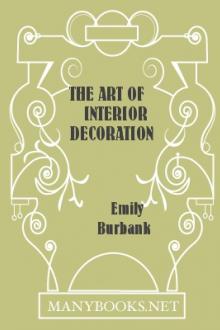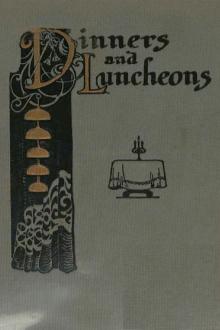The Art of Interior Decoration, Emily Burbank [big ebook reader txt] 📗

- Author: Emily Burbank
- Performer: -
Book online «The Art of Interior Decoration, Emily Burbank [big ebook reader txt] 📗». Author Emily Burbank
If you are buying pictures to hang in a picture gallery, there is nothing to consider beyond the attraction of the individual picture in mind. But if you are buying a picture to hang on the walls of a room which you are furnishing, you have first to consider it as pure decoration; that is, to ask yourself if in colour, period and subject it carries out the idea of your room.
A modern picture is usually out of place in a room furnished with antiques. In the same way a strictly modern room is not a good setting for an old picture, if toned by time.
If you own or would own a modern portrait or landscape and it is the work of an artist, and beautiful in colour, why not "star" it,—build your room up to it? If you decide to do this, see that everything else representing colour is either subservient to the picture, or if of equal value as to colour, that they harmonise perfectly with the picture in mind.
From a studio one enters a smaller room, one side of which is shown here, a veritable Italian Louis XVI salon.

We were recently shown a painting giving a view of Central Park from the Plaza Hotel, New York, under a heavy fall of snow, in the late afternoon, when the daylight still lingered, although the electric lights had begun to spangle the scene. The prevailing tone was a delicate, opalescent white, shading from blue to mauve, and we were told that one of our leading decorators intended to hang it in a blue room which he was furnishing for a New York client.
Etchings are at their best with other etchings, engravings or water colours, and should be hung in rooms flooded with light and delicately furnished.
The crowding of walls with pictures is always bad; hang only as many as furnish the walls, and have these on a line with the eye and when the pictures vary but slightly in size make a point of having either the tops of the frames or the bottoms on the same line,—that is, an equal distance from floor or ceiling. If this rule is observed a sense of order and restfulness is communicated to the observer.
If one picture is hung over the other uniformity and balance must be preserved.
One large picture may be balanced by two smaller ones.
Hang your miniatures in a straight line across your wall, under a large picture or in a straight line—one under the other, down a narrow wall panel.
CHAPTER VIII TREATMENT OF PIANO CASESA professional pianist invariably prefers the case of his or her piano left in its simple ebony or mahogany, and would not approve of its being relegated to the furniture department and decorated accordingly, any more than your violinist, or harpist, would hand over his violin, or harp, for decoration.
When a piano, however, is not the centre of interest in a house, and the artistic ensemble of decorative line and colour is, the piano case is often ordered at the piano factory to be made to accord in line with the period of the room for which it is intended, after which it is decorated so as to harmonise with the colours in the room. This can be done through the piano factory; but in the case of redecorating a room, one can easily get some independent artist to do this work, a man who has made a study of the decorations on old spinets in palaces, private mansions and museums. Some artists have been very successful in converting what was an inartistic piece of furniture as to size, outline and colour, into an object which became a pleasing portion of the colour scheme because in proper relation to the whole.
You can always make an ebony or mahogany piano case more in harmony with its setting by covering it, when not in use, with a piece of beautiful old brocade, or a modern reproduction.
Another side of same Italian Louis XVI salon. The tea-table is a modern painted convenience, the two vases are Italian pharmacy jars and the standard for electric lights is a modern-painted piece.

A dining-room buffet requires the same dignity of treatment demanded by a mantelpiece whether the silver articles kept on it be of great or small intrinsic value. Here, as in every case, appropriateness dictates the variety of articles, and the observance of the rule that there shall be no crowding nor disorder in the placing of articles insures that they contribute decorative value; in a word, the size of your buffet limits the amount of silver, glass, etc., to be placed upon it.
The variety and number of articles on a dressing-table are subject to the same two laws: that is, every article must be useful and in line and colour accord with the deliberate scheme of your room, and there must be no crowding nor disorder, no matter how rare or beautiful the toilet articles are.
CHAPTER X TREATMENT OF WORK TABLES, BIRD CAGES, DOG BASKETS AND FISH GLOBESEvery bedroom planned for a woman, young or old, calls for a work table, work basket or work bag, or all three, and these furnish opportunities for additional "flowers" in your room; for we insist upon regarding accessories as opportunities for extra colour notes which harmonise with the main colour scheme and enliven your interior quite as flowers would, cheering it up—and, incidentally, its inmates! Apropos of this, it was only the other day that some one remarked in our hearing, "This room is so blooming with lovely bits of colour in lamp shades, pillows, and objets d'art, that I no longer spend money on cut flowers." There we have it! Precisely the idea we are trying to express. So make your work-table, if you own the sort with a silk work-bag suspended from the lower part, your work-basket or work-bag, represent one, two or three of the colours in your room.
If some one gives you an inharmonious work-bag, either build a room up to it, or give it away, but never hang it out in a room done in an altogether different colour scheme.
Bird-cages, dog-baskets and fish-globes may become harmonious instead of jarring colour notes, if one will give a little thought to the matter. In fact some of the black iron wrought cages when occupied by a wonderful parrot with feathers of blue and orange, red and grey, or red, blue and yellow, can be the making of certain rooms. And there are canaries with deep orange feathers which look most decorative in cages painted dark green, as well as the many-coloured paroquet, lovely behind golden bars.
Many a woman when selecting a dog has bought one which harmonised with her costume, or got a costume to set off her dog! Certainly a dark or light brindle bull is a perfect addition to a room done in browns, as is a red Chow or a tortoise-shell cat.
See to it that cage and basket set off your bird, dog or cat; but don't let them become too conspicuous notes of colour in your room or on your porch; let it be the bird, the dog or the cat which has a colour value.
The fish-globe can be of white or any colour glass you prefer, and your fish vivid or pale in tone; whichever it is, be sure that they furnish a needed—not a superfluous—tone of colour in a room or on a porch.
Shows narrow hall in an old country house, thought impossible as to appearance, but made charming by "pushing out" the wall with an antique painted tapestry and keeping all woodwork and carpets the same delicate dove grey.

Nothing is ever more attractive than the big open fireplace, piled with blazing logs, and with fire-dogs or andirons of brass or black iron, as may accord with the character of your room. If yours is a period room it is possible to get andirons to match, veritable old ones, by paying for them. The attractiveness of a fireplace depends largely upon its proportions. To look well it should always be wider than high, and deep enough to insure that the smoke goes up the chimney, and not out into your room. If your fireplace smokes you may need a special flue, leading from fireplace to proper chimney top, or a brass hood put on front of the fireplace.
Many otherwise attractive fireplaces are spoiled by using the wrong kind of tiles to frame them. Shiny, enamelled tiles in any colour, are bad, and pressed red brick of the usual sort equally bad, so if you are planning the fireplace of an informal room, choose tiles with a dull finish or brick with a simple rough finish. In period rooms often beautiful light or heavy mouldings entirely frame the three sides of the fireplace when it is of wood. Well designed marble mantels are always desirable. This feature of decoration is distinctly within the province of your architect, one reason more why he and the interior decorator, whether professional or amateur, should continually confer while building or rebuilding a house.
For coal fires we have a variety of low, broad grates; as well as reproductions of Colonial grates, which are small and swung high between brass uprights, framing the fireplace, with an ash drawer, the front of which is brass. If you prefer the old, one can find this variety of grate in antique shops as well as "Franklin stoves" (portable open fireplaces).
If your rooms are heated with steam, cover the radiators with wooden frames in line with the period of your room cut in open designs to allow heat to come through, and painted to match the woodwork of the room. See Plate XIX.
Let the fireplace be the centre of attraction in your room and draw about it comfortable chairs, sofas and settles,—make it easy to enjoy its hospitable blaze.
CHAPTER XII TREATMENT OF BATHROOMSSumptuous bathrooms are not modern inventions, on the contrary the bath was a religion with the ancient Greeks, and a luxury to the early Italians. What we have to say here is in regard to the bath as a necessity for all classes.
The treatment of bathrooms has become an interesting branch of interior decoration, whereas once it was left entirely to the architect and plumber.
First, one has to decide whether the bathroom is to be finished in conventional white enamel, which cannot be surpassed for dainty appearance and sanitary cleanliness. Equally dainty to look at and offering the same degree of sanitary cleanliness, is a bathroom enamelled in some delicate tone to accord in colour with the bedroom with which it connects.
This illustration speaks for itself—fruit dishes and fruit, candlesticks, covered jars for dried rose leaves, finger bowls, powder boxes, flower vase, and scent bottles—all of Venetian Glass in exquisite shades.

Some go so far as to make the bathroom the same colour as





Comments (0)